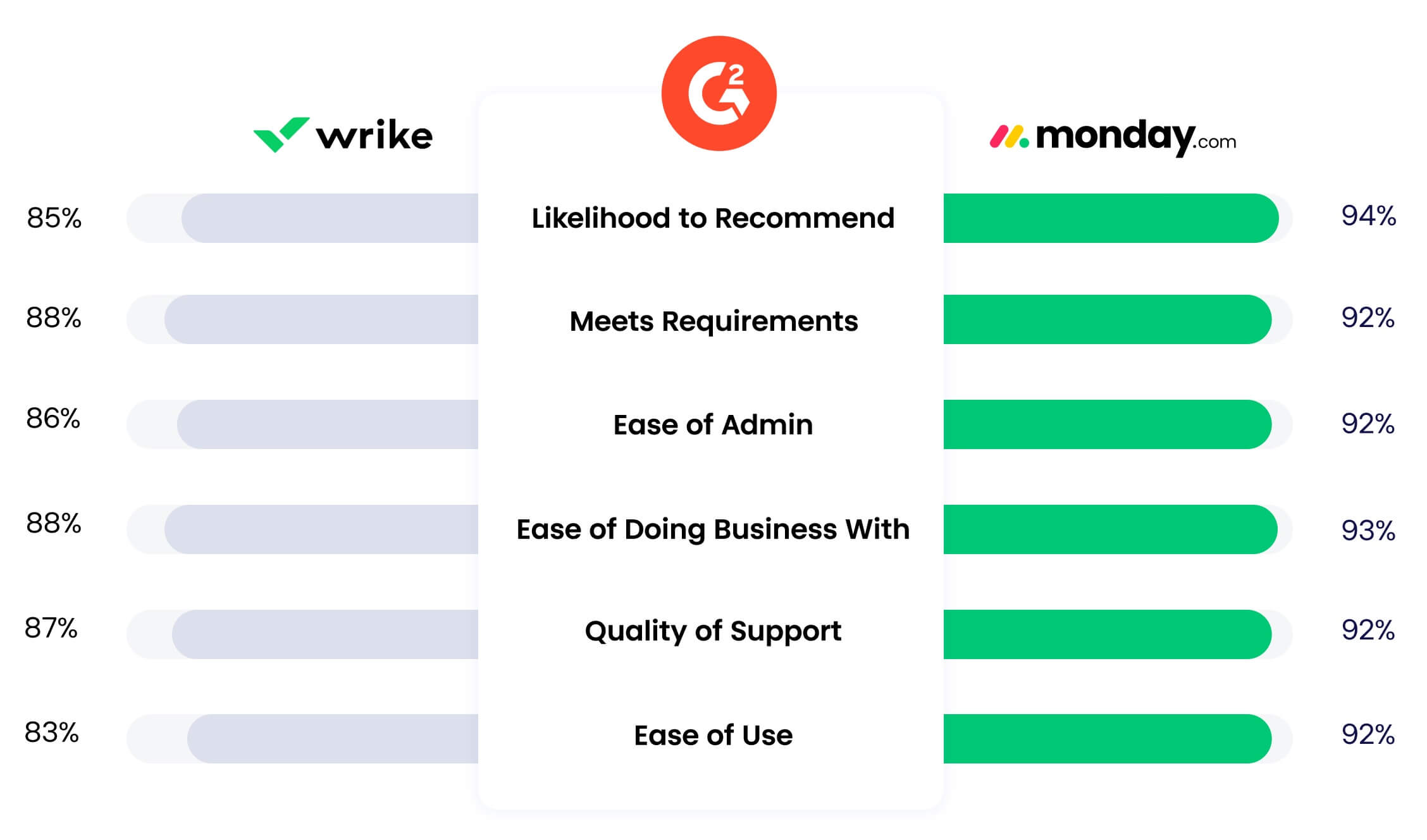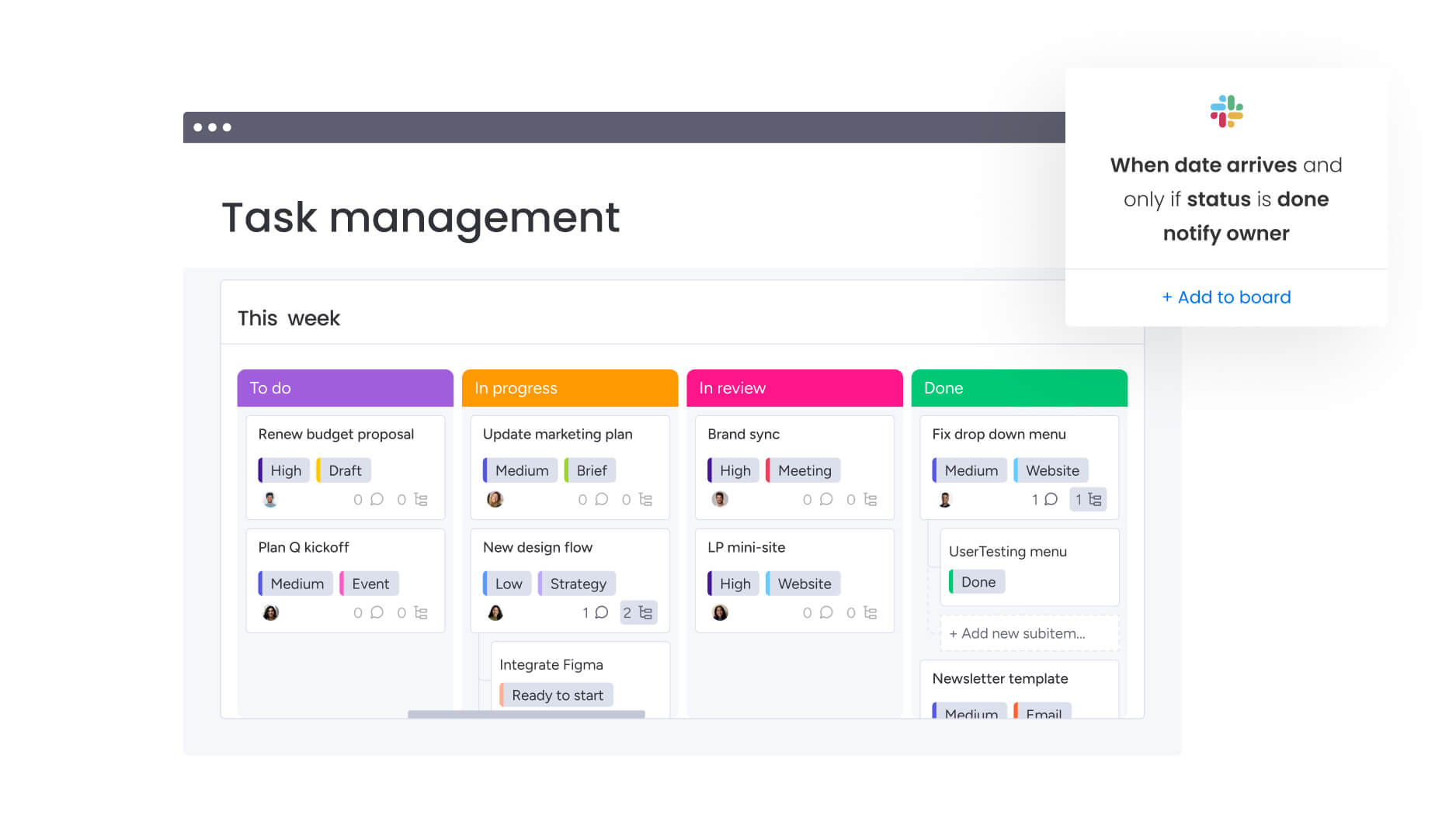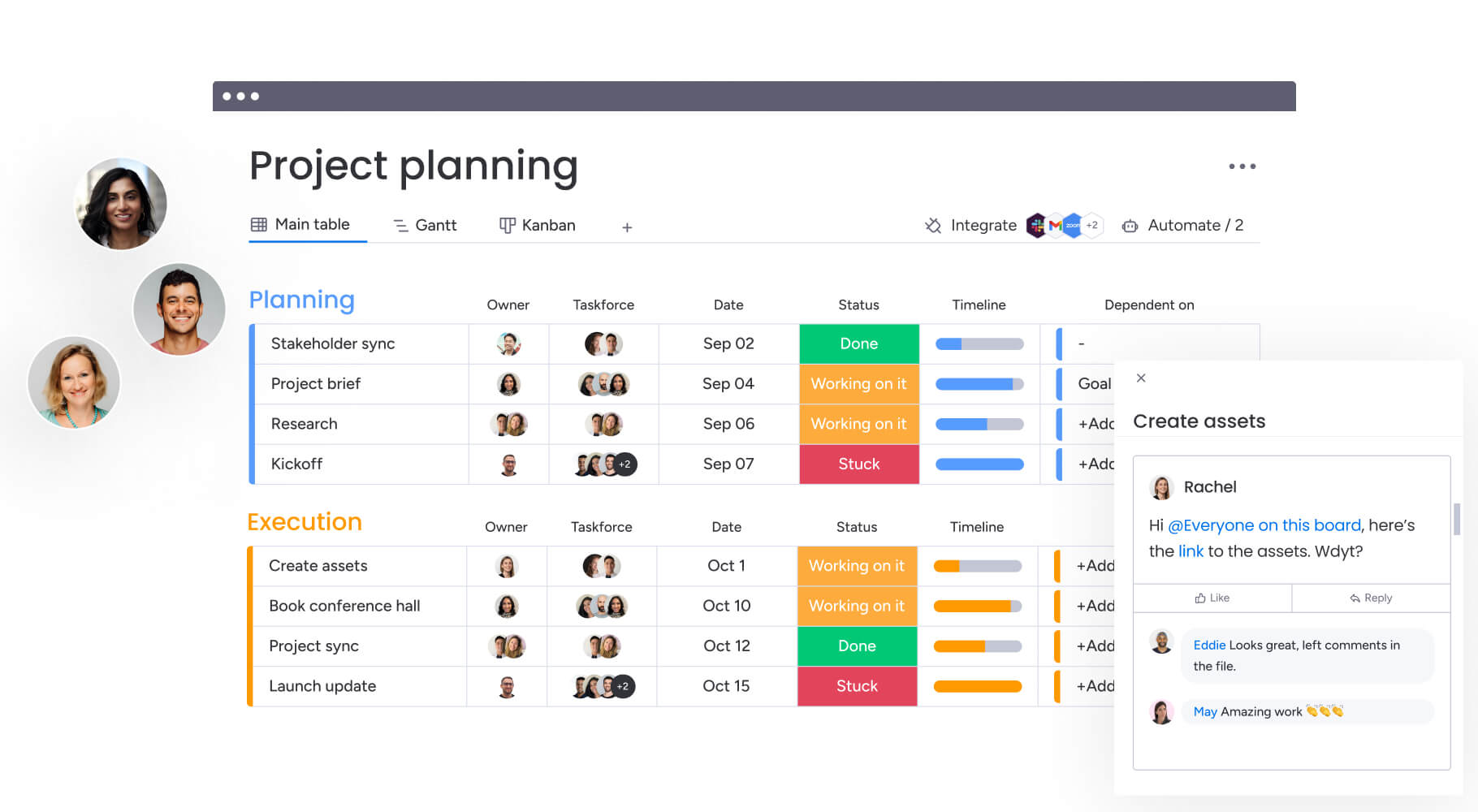Shifting away from emails and spreadsheets may feel like leaving your comfort zone. However, once you move to an intuitive platform that pools together all your most important contacts, communications, and documents, you’ll wonder how you ever managed your work without it.
Project management software like Wrike helps you keep all your work organized in one place. Wrike is a project and work management platform that enables teams to track progress on projects and tasks while collaborating and communicating efficiently. As one of the more popular project management platforms, it’s often a go-to for many teams. However, before selecting software for your business it’s important to familiarize yourself with its features, pricing, and alternatives.
In this post, we’ll walk you through our Wrike review and go over the platform’s main features, its pros and cons, Wrike pricing, and look at a project management competitor, monday.com, to see how it makes for a solid alternative.
Get startedAbout Wrike
Wrike is a project management and collaboration platform that helps teams of all sizes tackle tasks and manage work. Wrike caters to all kinds of industries and types of teams and is used by small businesses and large enterprises alike.
As a collaboration tool, Wrike enables teams to communicate on tasks and project milestones, helping teams work towards common goals and track their progress. The user interface is intuitive and easy to use and includes interactive features like visual timelines, Gantt charts, and more.
With its automation capabilities, teams can reduce their reliance on manual and repetitive tasks to speed up workflows. Assigning tasks, getting reminders, or sending follow-ups can all be automated in just a few clicks, helping teams stay on top of their assignments. Additionally, Wrike integrates with several popular work tools, such as Microsoft Teams, Google Apps, Salesforce, Shopify, and over 400 others.
Whether you’re managing simple tasks or a complex project, Wrike enables teams to collaborate efficiently and in real-time, while simultaneously improving project visibility, helping teams meet their goals, and boosting overall project success.
Wrike pricing: a five-tier model
We’ll go over Wrike pricing and plans so that you can make the best decision for your team. In short, Wrike’s pricing works based on five plans: Free, Team, Business, Enterprise, and Pinnacle.
Free plan
Cost: Free forever
Users: Unlimited
Individual users or small teams just getting started with their businesses can use Wrike’s free plan for centralized task management.
Here’s what you get with the free plan:
- Web, desktop, and mobile apps
- Task & subtask management
- Interactive board and spreadsheet views
- Cloud storage integrations (Google Drive, Dropbox, Box, MSFT Office 365, and OneDrive)
- 2 GB storage space per account
Although Wrike’s free plan includes unlimited users, a few features are lacking from this plan that Wrike competitors have. These include features like customizable notifications, shareable forms, and free templates so organizations can choose a structure, add in their information, and start working within minutes.
Team plan
Cost: $9.80/user/month
Users: 3-25
Let’s look into which features you get for that price range:
- Unlimited projects, tasks, and request forms
- 20 free collaborators
- Interactive Gantt charts
- More work views like analytics and calendar
- 2GB of storage per user
A few notable features are missing here, including automations and expanded storage space. Growing companies may need to pay more to increase storage space, which goes fast when working on various projects.
Business plan
Cost: $24.80/user/month
Users: 5-200
In addition to everything from the Team plan, here’s what you’ll get in the Business plan:
- 200 automation actions per user per month
- File and video proofing feature
- Reporting and unlimited dashboards
- Folder structure and nested projects
- AI risk prediction and work creation
- 5GB of storage per user
If you’re looking for task management software that scales with your business, flexibility is key, which is why a plan like this one is ideal for growing teams. Since the Business plan is the first tier to offer automations, it’s probably the best choice for small to medium teams who want to make their workflows more efficient.
Enterprise plan
Cost: Custom
Users: 5 to unlimited
Wrike’s Enterprise plan is built for larger teams that need enterprise-grade security and scalability. Like most competitors, the Enterprise plan is typically more customizable and geared to meet specific needs, and as a result, pricing is offered by contacting the sales team only.
Here’s what you get with Wrike’s fourth-tier plan:
- Two-factor authentication (2FA)
- Password policies
- Custom access roles
- Admin permissions
- User audit reports
- 1000 automation actions per user per month
- 10 GB storage per user
The main selling point of this plan is enterprise-grade security, which is essential for larger teams and businesses, especially when working on multiple projects that involve sensitive data.
Pinnacle plan
Cost: Custom
Users: 5 to unlimited
Including everything in the Enterprise plan, the Pinnacle plan goes a step further with more advanced tools for complex work, such as:
- Locked spaces
- Advanced reporting & BI
- Budgeting and billable hours
- Bookings
- 1500 automation actions per user per month
- 15 GB storage per user
For large teams handling complex projects, this plan is ideal to tackle every task without compromising on functionality and security.
Streamlining workflows with Wrike
Taking a closer look at the features, advantages, and disadvantages of Wrike’s platform, we can begin to see where it shines. Wrike claims its platform can “transform the way you work” with its features and easy-to-use platform. Let’s take a closer look at some of Wrike’s key features to see what makes it stand out from the competition.
Wrike top features
- Multiple work views: Work your way with multiple work views like Gantt, Kanban, timeline, board, workload, calendar, and more
- Proofing: Share feedback within tools on different file types, like documents, images, videos, and more, leading to real-time creative collaboration
- Workflow automation: Put recurring workflows on autopilot and cut down on repetitive activities and human error by creating your own custom automations
- Reports and analytics: Gain insights into your project and task progress with advanced analytics, business insights, and real-time reporting
- Generative AI: With generative AI built-in to Wrike’s platform, your team can create project content and detailed documents in seconds tailored to your brand’s voice
Wrike Pros
- Easy-to-use interface
- Templates to get started quickly
- Users can customize their dashboards to their liking
- Impressive Gantt chart feature
- Free plan
Wrike Cons
- Can be costly for smaller teams
- Users have reported some notifications are delayed
- Steep learning curve to get used to all the features
- Dashboards only shareable on paid plans
Is Wrike right for your team?
Wrike is a great choice for a lot of teams. It can cater to different needs, making it fitting for different industries, it’s customizable, and there are plans for each price point. Its integration capabilities and visual project planning tools make it suitable for multiple project sizes and different needs, and its extensive list of features is great for teams looking for options.
That said, Wrike may not be the best fit for every team. On popular review site, G2, Wrike users claim that the platform is less suitable for certain teams and projects, like software development and Agile processes. Furthermore, users also mention that Wrike pricing is relatively high and some of the plans include features that aren’t always useful to their projects, making it a robust system that can be difficult to adopt across departments. This can lead to a prolonged onboarding process and some team members, especially those who are more technologically limited, feeling overwhelmed.
As an alternative to the popular project management tool, we recommend considering monday.com, which offers teams of all sizes greater flexibility and customization.
Get startedHow does monday.com compare to Wrike?

Small teams just getting started don’t need all the functionalities that come with more advanced plans. Overall, we’ve found that Wrike’s free plan functions nicely as a digital bulletin board where you can add to-do lists. Organizations can certainly use it for task management or managing projects, but it does lack the options of other free models.
Moving past the free plan, Wrike’s limitations for development or Agile teams can be a sore spot for companies who want to implement one tool across multiple departments. In this regard, monday.com fills in those gaps. Built on top of the monday.com Work OS, monday work management caters to teams of all sizes, from individuals tackling projects on their own to large enterprises that have complex projects to manage.
While it has many similar features to Wrike, monday.com scores higher in user reviews and ease of use, making it more appealing to a wider breadth of teams. While Wrike scores 4.2/5 overall, monday.com’s G2 score sits at 4.7/5, making it the more well-liked work management platform.
A few things set monday.com apart from Wrike. For example, users report that automations are easy and more intuitive and that the platform offers greater flexibility. monday work management’s pricing reflects this flexibility, with plans for the monday work management project ranging from $9/seat/month for the Basic plan to $19/seat/month for the pro.
For the price, monday work management offers greater access to features, such as more automation and integration actions per month compared to Wrike. For example, monday work management’s Pro plan offers 25,000 automation and integration actions each.
What else can you do with monday.com?

monday.com’s cloud-based software platform enables teams to build any product they need from custom workflow apps. For example, sales teams can use our no-code/low-code structure to create CRM software, marketers can use it to plan, run, and track their campaigns, developers can use it to run sprints, and much, much more. As a work management platform, monday.com offers the following capabilities:
- Organization-wide use: monday.com can be helpful for teams of any size and in any department
- Data visualization and analytics: All users with permissions can create reports and visualizations within the platform. Dashboards and reports function as a single source of truth for data-driven decision-making
- Permissions and governance: monday.com includes permission-setting features over who can view, update, and edit data
- Integrations: The monday app marketplace offers over 200 different app integrations with the most popular work tools, keeping everything organized and accessible in one place
- Work view customization: With 27+ different work views to choose from, like Timeline, Workload, Gantt, Kanban, and others, you can choose to work in line with any method your team prefers

monday.com goes far beyond simple project management software. Engineers use monday.com to build plans, doctors utilize our platform to run clinical trials, and more than 100,000 teams use monday.com to get more work done, faster and more efficiently.
Get startedGet started with monday.com
While Wrike is a solid project management platform, if you’re looking for a fully customizable solution that can fit any industry or team’s needs, monday work management is your best bet.
With monday work management, you’ll have access to advanced integrations, sophisticated dashboards and analytics, and seamless transparency throughout your business.
In addition to our Wrike review, for a more in-depth comparison of monday.com and Wrike, we’ve looked at the two side-by-side, providing a rundown of each company’s pricing tiers and features. Take a look for a more detailed view of our review of monday.com vs Wrike of which platform might be a better fit for your team.
Related articles: Wrike vs. Asana, Wrike vs. Basecamp, Smartsheet vs. Wrike, Wrike vs. Jira, Wrike alternatives, monday.com alternatives
FAQs
Is Wrike free forever?
Wrike does offer a Free plan with no time limit, meaning it is free forever. That said, functionality is limited so if you plan on growing your team, it may not be the ideal long-term choice.
How long is Wrike free trial?
Wrike offers a free 14-day trial, which includes access to several features from paid plans so you can test it out before deciding which plan you want.
How many users can you have on Wrike’s Free plan?
With Wrike’s free plan, you can have unlimited users. However, keep in mind that while you can onboard your whole team, you can’t access Wrike’s full functionality with the Free plan.
 Get started
Get started 
